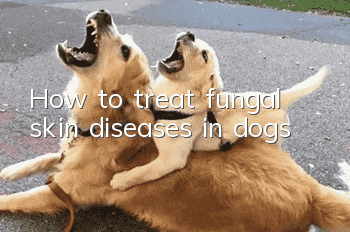How to treat fungal skin diseases in dogs?

Fungal skin disease is actually what people call “ringworm”. Parents often have no idea what to do about such symptoms and what to do. They can only watch their dogs suffer without being too anxious. First of all, we should analyze the causes. Fungal skin diseases in dogs are various skin diseases caused by skin molds that invade the skin, hair and keratin tissue of the dogs' toes and claws. In other words, it is caused by a variety of factors. . This disease is a zoonotic disease that occurs everywhere in the world!
1. Causes of fungal skin diseases in dogs
Above we have analyzed a series of systemic causes of fungal skin disease in dogs. So what are the specific causes of this disease in dogs? This must be a question that some parents can’t wait to confirm, so today I will introduce it to you. Let’s take a look at the specific causes of fungal skin diseases in dogs!
1. The occurrence of fungal skin diseases in dogs has a certain relationship with climate, age and physical constitution. For example, when the weather is hot and humid, the incidence rate will naturally be high, and dogs in childhood are more susceptible than adults. Dogs are more susceptible to infection because their immunity is extremely weak and their resistance is very poor. Dogs that are malnourished or weak are more susceptible to this disease than dogs that are in good health and are strong. Therefore, parents should pay more attention to their puppies!
2. If large doses of hormones are taken clinically for a long time, it will not only cause the dog’s resistance to decrease, but also easily cause the dog to be infected with the disease!
3. According to statistics, five types of molds have been found to easily cause skin mycosis in dogs, namely: Microsporum canis, Microsporum gypseum, Trichophyton mentagrophyton, and Microsporum audouinii. bacteria and Microsporum proteus. Among them, Microsporum canis is the most common, followed by Microsporum gypsum, followed by Trichophyton mentagrophytes and Microsporum audouinii. The distribution of Microsporum mutans is very small, only in a few countries, and The incidence is very low.
2. Preventive measures for fungal skin diseases in dogs
Dogs get this disease, largely because preventive measures are not taken. If these measures are taken, owners, your dogs can escape the disaster. Next, what I want to introduce to you is how to nip it in the bud and how to take preventive measures to save more dogs from it. Parents don’t have to worry about it day and night! Fungal skin There are no special prevention and treatment measures for the disease. The main thing is to do basic epidemic prevention work and daily management!
1. Personal hygiene
Parents must keep their dogs’ skin clean and hygienic, and check their skin frequentlyAre there any ringworm spots or scales?
2. Diet
Nutrition must be strengthened and the dog’s daily life must be well managed. The dog's diet should contain enough protein, as well as various vitamins, minerals and some trace elements, which can enhance the dog's resistance. At the same time, the dog’s shed and surrounding environment must be disinfected regularly, especially in spring and autumn and humid seasons. If conditions permit, the owner can use medicated soap or pet-specific liquid to bathe the dog. When washing, be careful not to scratch the dog’s skin!
3. Public health
Fungal skin disease in dogs is a zoonotic infectious disease. Therefore, public health must be paid attention to to prevent it from being transmitted from humans to dogs, or from dogs to humans. All fungal skin diseases in dogs may be transmitted to humans, especially children who are prone to infection, causing tinea capitis or other ringworms. Therefore, owners must pay attention to this to prevent humans and dogs from suffering from this disease. !
3. Treatment of fungal skin diseases in dogs
1. Treat the affected area
First, parents should clean the area where the fungus is and cut off the hair. This will allow the medicine to better penetrate into the skin and avoid the spread of the fungus. Then, when applying the medicine, the scope of the medicine can be appropriately expanded, so as to better inhibit the fungi that may have spread to other places!
2. Bask in the sunshine
Many parents know that ultraviolet rays in the sun can effectively kill mold, but do not expose your dog to the sun. If you are not careful, it will cause heatstroke or sunburn! You can also spend some time on the balcony every day. The sunshine of time!
3. Take regular baths
It is best for dogs infected with fungi to use special towels, bath liquid, or sulfur soap for a long time. Since fungi are contagious, you must do a good job of disinfection and disinfection!
- How should I raise a Husky puppy when it is one month old?
- Border Collie Price | Training | Introduction
- How big should Teddy be vaccinated?
- What will happen if puppies eat adult dog food?
- Prevention and Treatment of Dog Gastroenteritis Symptoms
- How long does it take for a dog’s surgical wound to return to normal?
- Does raising a dog require a dog crate?
- What's going on with Teddy's tail?
- Are dogs nearsighted?
- How to Treat Greyhound Distemper



